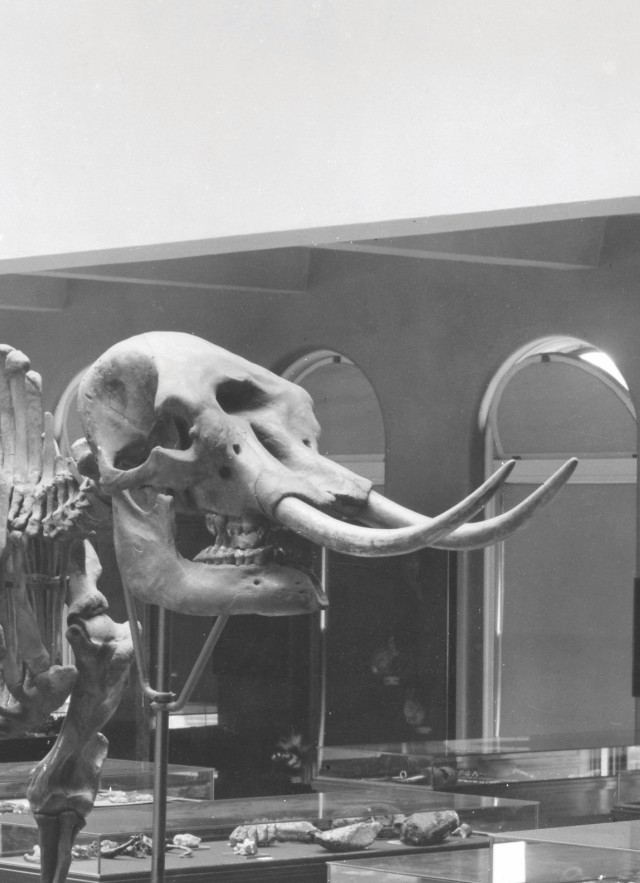The NHM Story

The Natural History Museum of Los Angeles County (NHM) is situated on land that served as an agricultural fairground from 1872 until 1910.
In the 1890s, a local attorney and Sunday school teacher, William Miller Bowen, became increasingly alarmed by the growing numbers of saloons, gambling events, and other vices that existed in the park. He led the 1909 fight to convince the State, County, and City to develop the park as a cultural center. In this plan, the State would build an exposition building for California products (and later an armory); the County would build a historical and art museum; and the City would maintain the grounds. This tripartite ownership still exists today.
The museum building was located on the western axis of the proposed sunken rose garden of Agricultural Park, renamed Exposition Park in December 1910. On December 17 of that year, with Bowen, Mayor George Alexander, future California Governor William H. Stephens and other dignitaries in attendance, and with the Grand Lodge of Masons of California officiating, the Museum’s cornerstone was laid and construction began.
The Original Museum
The original structure—what is today known colloquially as the 1913 Building—was designed by local architects Frank Hudson and William A.D. Munsell. It incorporated an eclectic blend of styles: Spanish Renaissance ornamentation is seen in the terracotta trimmings; Romanesque style in the arched windows and the brick walls; and the Beaux Arts tradition in the T-shaped floor plan.
The focal point of the 1913 Building was, and is today, the rotunda, which measures 75 feet in diameter with three wings. The rotunda’s walls are made of Italian marble, its floor of mosaic tile. Julia Bracken Wendt’s “Three Muses” statue graces its center. The rotunda’s dome is 58 feet in height, with a skylight approximately 20 feet across, designed by the eminent Walter Horace Judson.
As the Museum was being built, four local organizations—the Historical Society of Southern California, the Cooper Ornithological Club, the Southern California Academy of Sciences, and the Fine Arts League—were persuaded to fill the galleries of the new museum. The museum was given the exclusive rights in 1913 to remove the prehistoric remains from the tar pits at Rancho La Brea. Mammal skeletons continued to dominate the science wing of the museum until 1976, when they were moved to the newly-opened George C. Page Museum of La Brea Discoveries in Hancock Park.
The Grand Opening
On November 6, 1913, Exposition Park and the new museum—called then the Los Angeles County Museum of History, Science, and Art at the time—opened formally to the public. A two-week civic celebration ensued, dovetailing with the opening of the Owens River Aqueduct. In the San Fernando Valley, William Mulholland would declare of the water in his famously short speech, “There it is, take it.” In Exposition Park, U.S. Senator John D. Works dedicated the site of a fountain that would occupy the center of a sunken garden as a commemoration of that aqueduct. As Senator Works left the platform, a jet of water shot up 30 feet.
The history, science and art collection of the museum gradually outgrew the capacity of the 1913 Building, and the original structure was expanded. In 1963, the Art Department relocated to its own museum in Hancock Park (the Los Angeles County Museum of Art). At that time, the Exposition Park facility became the Natural History Museum of Los Angeles County (NHM). NHM was joined by other major cultural facilities in the park: the Memorial Coliseum, Sports Arena, Swimming Stadium, California Science Center, California African American Museum, and the largest municipal-owned rose garden in the nation.
Renovation and Preservation
After more than two years of renovation and architectural preservation, the 1913 Building re-opened in the spring of 2009. In addition to a seismic retrofit, the early phase of construction also focused on the restoration of the brilliantly colored stained glass skylight at the apex of the Rotunda. This exacting work was carried out by David Judson, grandson of the skylight’s designer, Walter Horace Judson. Under David’s direction, the ornate and elegant stained glass was cleaned, repaired and strengthened, bringing it back to its full glory.
Using extensive data from NHM’s own archives—including historic drawings, photos and documents—the project team uncovered the original design, layout and construction methods of the original building and its subsequent 1920s additions in order to restore the building, while modernizing it inside and out. The 1913 Building’s first exhibition, Age of Mammals, debuted in 2010, the Dinosaur Hall in July, 2011, and Becoming Los Angeles in 2013.